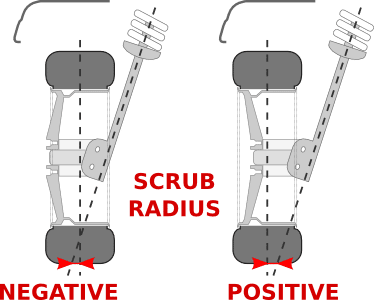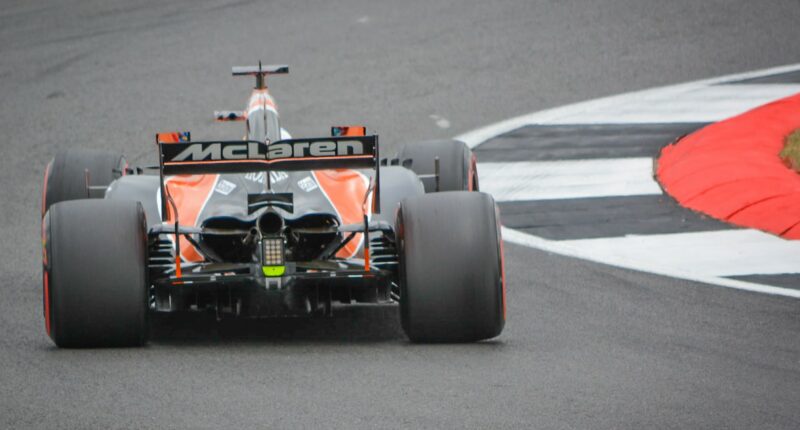When you start making suspension and wheel modifications, there’s bound to be a change in scrub radius too. This could have a significant impact on the handling of your car and even affect the advanced driver assistance systems such as lane-keep assist.
You have to understand the factors that wheel and suspension geometry set up have an impact on to avoid having a car that has subpar handling and feels worse to drive.
In this guide, we’ll explain what scrub radius is, the different types of scrub radius and their effects on your car’s handling and performance.
What is Scrub Radius?
To visualize scrub radius, stand in front of your car. Picture two imaginary lines, one represents the steering axis, and the other represents your wheel’s centerline. The scrub radius is the distance between the two, where both touch the road.
If you alter the alignment and the suspension angles by changing the wheel’s width and diameter, it can affect the offset and change the point where the flange centerline and steering axis touch the ground.
The result is a scrub radius, which directly affects your car’s stability, handling, and tire wear.
Sometimes drivers aren’t even aware that they unintentionally change the scrub radius when fitting custom wheels and oversized tires. The ones who intentionally adjust the scrub radius do it to change the car’s handling.
Types of Scrub Radius Explained
Different scrub radius configurations suit different cars. Before diving into them, it’ll help to visualize both short-long arm suspension and steering axis, or king pin inclination.
For starters, let’s talk about the steering axis which is a straight line, found between the upper and lower ball joints of the hub on a short-long arm (SLA). Steering axis inclination (SAI), on the other hand, is the angle between the centerline of the wheel and the steering axis.

When the steering axis intersection point is inside the contact patch, the scrub radius is positive.
With the MacPherson strut suspension, the steering axis is the straight line between the top strut bearing the lower ball joint. The angle between the steering axis and the centerline of the wheel is the SAI.
Positive Scrub Radius
With a positive scrub radius, the tire will not turn on its centerline, causing it to scrub the road when you turn. For you, this means exerting more effort.
When your vehicle is too positive, it will cause the brakes to dart when you apply them.
Effects of Positive Scrub Radius
If you have an RWD car with a positive scrub radius, the friction between the tire and the road will move the front wheels back and will keep the vehicle going straight.
When you brake and your effort is greater on one side of the car than the other, a positive scrub radius will make the car turn to the side where effort is greater.
You’ll find that a positive scrub radius is useful with certain racing setups. It’s also a standard setting with many double-wishbone suspension designs.
Advantages
- Keeps an RWD vehicle straight when there’s friction between the tire and road
- The tire does not turn on its centerline
Disadvantages
- Brakes dart when it’s too positive
- Requires more effort to make the car turn to the side
So how do you reduce a positive scrub radius? By increasing your tire size.
Alternately you can increase the scrub radius by fitting a smaller-size front tire on an RWD car. Your other option is to fit a wider wheel, which will move the tire centerline away from the vehicle.

Negative Scrub Radius
A scrub radius is negative if the steering axis intersection point is outside the center of the contact patch.
Also, in a negative scrub radius, your tire will not turn on the centerline and will require more effort to turn because of the increased friction.
Effects of Negative Scrub Radius
A car with a negative scrub radius tends to move the car away from the side of the greatest effort when you brake. The size of the scrub radius will determine how far it veers.
When your car has a significant negative scrub radius, you’ll find that it’s unstable and provides less feedback. It’s common for FWD vehicles to have a negative scrub radius. It acts as a safety mechanism if one brake circuit fails because it has a diagonal split braking system.
One of the benefits of a negative scrub radius is that the suspension geometry compensates for the split braking. When one half of the brake system fails, your vehicle will pull up in a straight line.
Another benefit is that it provides center point steering when your tire deflates. That’ll give you greater stability and steering control.
Advantages
- Provides center point steering when tires deflate
- The geometry compensates for the split braking
Disadvantages
- Can become positive if you move the wheel offset too far from the hub
- Low power engines will not see any benefits
It’s mostly cars with high power engines that benefit the most from a negative scrub radius. If you want to decrease a negative scrub radius, you can fit a smaller diameter tire. This will move the contact patch away from the hub.
If you do it to the extreme, it could cause the scrub radius to change from positive to negative.
A negative scrub radius enables road forces to reduce your torque steering habit when you accelerate.

Zero Scrub Radius
A scrub radius is zero when the intersection point is centered in the contact patch. You’ll find that a zero scrub radius makes the car unstable at the front end while cornering, or when you have to brake hard.
It’s rare for a car to have a zero scrub radius because when the car is stationary, the steering turns the contact patch where it’s situated.
Not only does that require you to exert more effort, but you’ll also find that it wears out your tires, meaning spending more time making sure your tire pressure is spot-on.
Effects of Zero Scrub Radius
At low speed, having a car with zero scrub radius makes it easier to handle. It also helps to reduce the risk of your car changing direction. A loss of traction can cause that when you brake. The steering is less sensitive to braking with a zero scrub radius.
Because a zero scrub radius car can cause the suspension to be skittish under hard braking, you would ideally like a small amount of scrub radius be it positive or negative. That way you can at least generate some torque to a predictable side. You’ll notice that the steering is smoother this way.
When you set your car to zero scrub radius, it causes tire scrub in the opposite direction of rotation when you turn.
Although most cars will not have a zero scrub radius, it can happen unintentionally when you make changes to your ride height and wheel offset.
Advantages
- Provides great handling
- Steering is less sensitive to braking
Disadvantages
- Causes your car’s suspension to be skittish under hard braking
- Results in tire scrub
Scrub Radius: Why It Matters
Scrub radius can be a good thing depending on what’s expected out of the car, whether it’s rear or front wheel drive, whether it’s a track car or a fun car to drive daily.
Its purpose is to provide a turning moment that attempts to turn the wheel away from the central position when the vehicle is in motion.
In simpler words, when you run any type of scrub radius, your wheels won’t always be pointed dead straight when you brake or accelerate.
When opting between the different scrub radius set ups, it’s always best to have a car with a positive or negative scrub radius, even if it’s just slightly in either direction. Just be careful that your car is set to the one you want and hasn’t switched from one to the other unintentionally because of tire changes.
What are your thoughts and experiences with scrub radius? Tell us in the comments below!


3 comments
How is the ‘amount’ of scrub radius measured? Will it be by mm’s between the two axis intersection points on the contact patch, or the angle of deflection between the wheel centerline and steering axis and point of intersection, and whether above the contact patch or below. Would a 5 mm scrub radius measurement be mild or a 10 mm scrub radius be severe? As I am evaluating changing rims, and wheel dimensions, I see a indicator for scrub radius, whether zero for the OE wheels and tires to positive scrub radius for wider tires and reduced offset. I would expect expect a mild positive scrub radius for my Toyota 86 to be a beneficial, for on-track driving. Thanks for your reply.
You explained it very interestingly.
My BMW Series 2 M235i xDrive Gran Coupe has factory tires 225 x 40 x 18 on an 8″ rim with ET 54
I would like to replace them due to increased comfort for a slightly higher 225 x45 x18 on an 8″ rim with ET 57
The simulation on the Rim & Tire Size Calculator shows that my new setup now has a Negative scrub radius of about -7mm compared to the previous factory original.
Will this negative value of 7 affect the handling or is it within the +- standard foreseen >
I can’t find any answers anywhere.
Christopher
London UK
Increasing the ET wheel offset will slightly increase negative scrub radius. But the your increase of total wheel diameter (40 to 45) will affect speedo accuracy by about 3kph. In 1974 Volkswagen Australia showed a promotional video (16mm film) in their dealer training which extolled the much improved cornering of the newly introduced FWD Passat with VW’s newest innovation of “negative steering roll radius” (aka Negative Scrub Radius) which was subsequently copied by Holden who called it “radial tuned suspension”. The video explained how negative steering roll radius was very desirous, especially under uneven braking grip/road friction of the front wheels in emergency situations such as oil or gravel in one side of the car. The vehicle will pull up in a straight line. This makes negative scrub radius advantageous in these situations which are are much more common that one half of the brake system failure. Changing form ET 54 to ET57 will only slightly increase the recommended negative scrub radius to. But too much of a good thing is not always better.